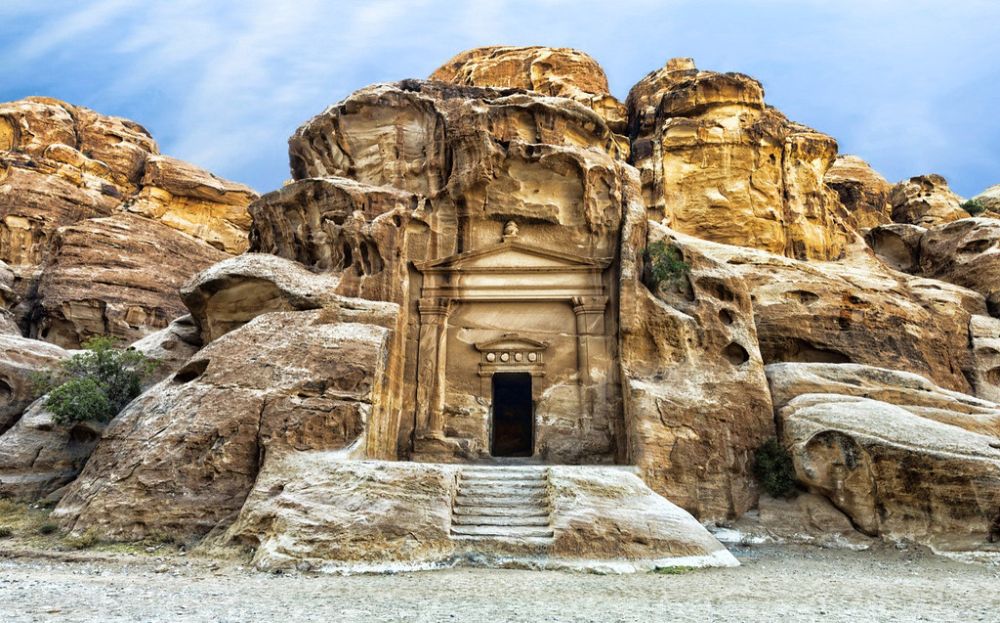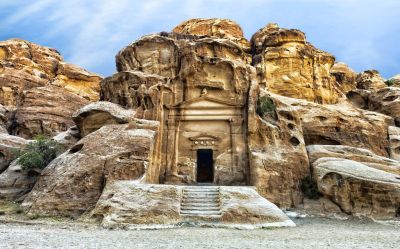

Little Petra, also known as Siq al-Barid, is a historical archaeological site located north of the main Petra city. Visitors can explore the ancient Nabatean tombs carved out of pink sandstone cliffs, resembling the style of the more famous Petra but without the crowds. These tombs, which date back to the 1st century AD, showcase the craftsmanship and artistry of the Nabatean people. As you walk through the small siq (canyon), scenes of a bygone era come to life, offering a glimpse into the past of caravan trading routes. Some tombs feature ancient frescoes that have survived the test of time, providing a rare insight into Nabatean wall painting. Exploring these tombs is a journey through history that offers a deeper understanding of the Nabatean civilization.
The Painted Biclinium is one of the highlights of Little Petra, offering visitors a chance to see some of the only remaining Nabatean frescoes in the world. This small chamber, which served as a dining room in antiquity, is adorned with paintings that depict vines, flowers, birds, and figures. Despite centuries of exposure to the elements, the remnants of these frescoes offer a rare and precious glimpse into the art and culture of the Nabateans. Visitors are typically in awe of the delicate nature of the paintings and the sophistication they represent. Viewing the Painted Biclinium is a must-do activity for history buffs and art lovers alike, as it offers a unique window into an ancient civilization's aesthetic sensibilities.
Little Petra Archaeological Park is a must-visit for those interested in history and archaeology. Often overshadowed by the larger Petra, this site offers a more tranquil experience allowing visitors to leisurely explore the ancient ruins. As you walk through the park, discover rock-cut domestic buildings, temples, and tricliniums—dining rooms used for communal meals. The park is also home to the remains of what is believed to be a marketplace and a series of residential areas. Little Petra served as a suburb of Petra and was most likely a bustling center of commerce. The intimate scale of the structures and easy access to the site make it an enjoyable activity for everyone. The opportunity to walk freely among such well-preserved ruins is an immersive way to understand the daily life of the Nabateans.
Experience the local culture by dining at a Bedouin camp near Little Petra. The Bedouin people have lived in the region for centuries and offer unique hospitality that's deeply rooted in their nomadic traditions. Guests can sit under a starlit sky and enjoy traditional Jordanian dishes that are often cooked in an earthen oven called a zarb. Expect to be served a feast of meat, rice, and vegetables, seasoned with a variety of aromatic spices. The warmth of the Bedouin people, combined with the delicious flavors of their cuisine, creates a memorable culinary experience. Accompanied by stories and music, dining at a Bedouin camp is not just about food; it's about cultural exchange and making connections with the local community.
For the adventurous traveler, the mountains surrounding Little Petra offer excellent hiking opportunities. Rugged trails lead hikers to vantage points with breathtaking panoramic views of the surrounding desert landscape and the ancient city below. These hikes range from easy strolls to more challenging treks up steep and rocky paths. Experienced guides are recommended for the more difficult routes, ensuring safety and providing insight into the natural history and cultural significance of the area. Hikers may stumble upon various archaeological remains scattered across the landscape, hidden away from the main tourist trails. Whether you're a seasoned hiker or someone looking to stretch their legs, the mountains around Little Petra offer a rewarding and invigorating experience.
Experience the magic of Little Petra after dark with a nighttime lantern tour. As the sun sets and the stars begin to pepper the sky, visitors are led through the ancient siq by the warm glow of lanterns. The flickering light casts dramatic shadows on the towering rock faces and illuminates the rock-hewn architecture in a captivating way. Guides share tales of Nabatean history and folklore, creating an eerie yet enchanting atmosphere. The quiet of the evening allows for a more introspective visit to this ancient site, and the lack of crowds during these nighttime tours makes for a more intimate exploration. For those seeking a unique and atmospheric experience, a lantern tour of Little Petra promises to be both memorable and otherworldly.
With its stunning desert landscape and impressive rock-cut architecture, Little Petra is a photographer's dream. Photography workshops led by professional photographers are available to help you capture the essence of this ancient site. Participants will learn about lighting, composition, and technical settings to best photograph the natural and historical features of Little Petra. Workshops can cater to all levels of experience, from beginners wanting to learn the basics to advanced photographers aiming to refine their skills. The soft light of dawn or the golden hues of dusk provide the perfect conditions for dramatic and beautiful images. Joining a photography workshop in Little Petra is not only a chance to improve your photography skills but also to come away with stunning visual memories of your journey.
Exploring Little Petra on camelback is a thrilling and authentic way to experience the historical site. Camels were an integral part of the Nabatean culture and economy, serving as the primary mode of transportation along the incense trade routes. Today, visitors can enjoy a leisurely ride on these gentle creatures, led by local Bedouins who are experts in handling the animals. Camel rides can often be spontaneous, as there are usually camels nearby ready to take guests on a short jaunt. For those looking for a longer ride, arrangements can be made for extended excursions into the surrounding desert. Regardless of the duration, riding a camel offers a fun and memorable way to connect with the region's history and landscape.
Nabatean pottery is renowned for its intricacy and craftsmanship. Visitors to Little Petra have the opportunity to participate in pottery workshops, where skilled artisans teach the techniques and patterns characteristic of traditional ceramics. In these hands-on workshops, you can shape your clay creation on the wheel, imprinting it with your own design, or even replicating ancient Nabatean motifs. After the workshop, your piece will be fired in a kiln, which you can then take home as a unique and personalized souvenir. No previous pottery experience is necessary, making it an enjoyable activity for all ages. Engaging in a pottery workshop gives you a deeper appreciation for the ancient craftsmanship and offers a tangible connection to the past.
Jordanian cuisine is a delightful aspect of the broader Levantine culinary tradition, and culinary classes are available in the vicinity of Little Petra for those looking to delve into the flavors of the region. These classes guide you through the preparation of popular Jordanian dishes, such as mansaf (lamb cooked in a sauce of fermented dried yogurt and served with rice or bulgur) or maqluba (an upside-down rice and vegetable cake). Local chefs share their recipes and techniques, offering a unique and interactive way to learn about the local customs and gastronomy. At the end of the class, participants get to enjoy the fruits of their labor in a communal meal—a delicious and satisfying way to wrap up the experience.
